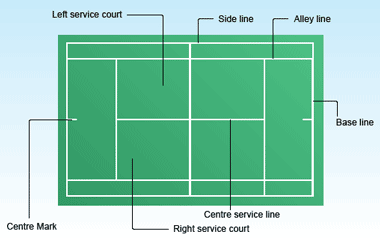Unlike some sports, there are few variations in the rules of Tennis. Both professional players in major competitions and amateur players taking part in casual matches tend to adhere to the same set of rules. The Official ITF Rules are extensive and cover every possible eventuality. A summary of the most important principles of Tennis for those unfamiliar with the sport is provided below.
The Court
A standard Tennis court is rectangular in shape and 78 feet long. For Singles matches, the court should be 27 feet wide, whilst for Doubles matches the court ought to be 36 feet wide. The same court can be used for both types of match as the lines marking the beginning of ‘the alleys,’ which run vertically up either side of the court, show where the Singles Court ends and the Doubles Court begins. The sidelines and baselines mark out the perimeter of the court.
A net is placed horizontally across the centre of the court, which marks the division between the territories of each respective player. On either side of the net are two rectangles of equal size, which both reach back to a line known as the service line. These rectangles are known as the service boxes. The service box used depends upon which player is the server and which side of the court they choose to serve towards.
There is also a larger rectangle, which extends along the length of the service line all the way back to the baseline. This area is known as the ‘backcourt’. The baseline marks the end of the court; a ball hit beyond the baseline (or sidelines) will be declared to be ‘out.’ The centre of the baseline is marked by a line predictably known as the Centre Mark. The server stands on this mark when serving the ball to the receiver.
The ‘alleys’ are each 4.5 feet wide. They extend from the net all the way back to the baseline in each direction. As the alleys are only used during Doubles matches, a ball which lands in an alley during a Singles match will be declared ‘out’.
